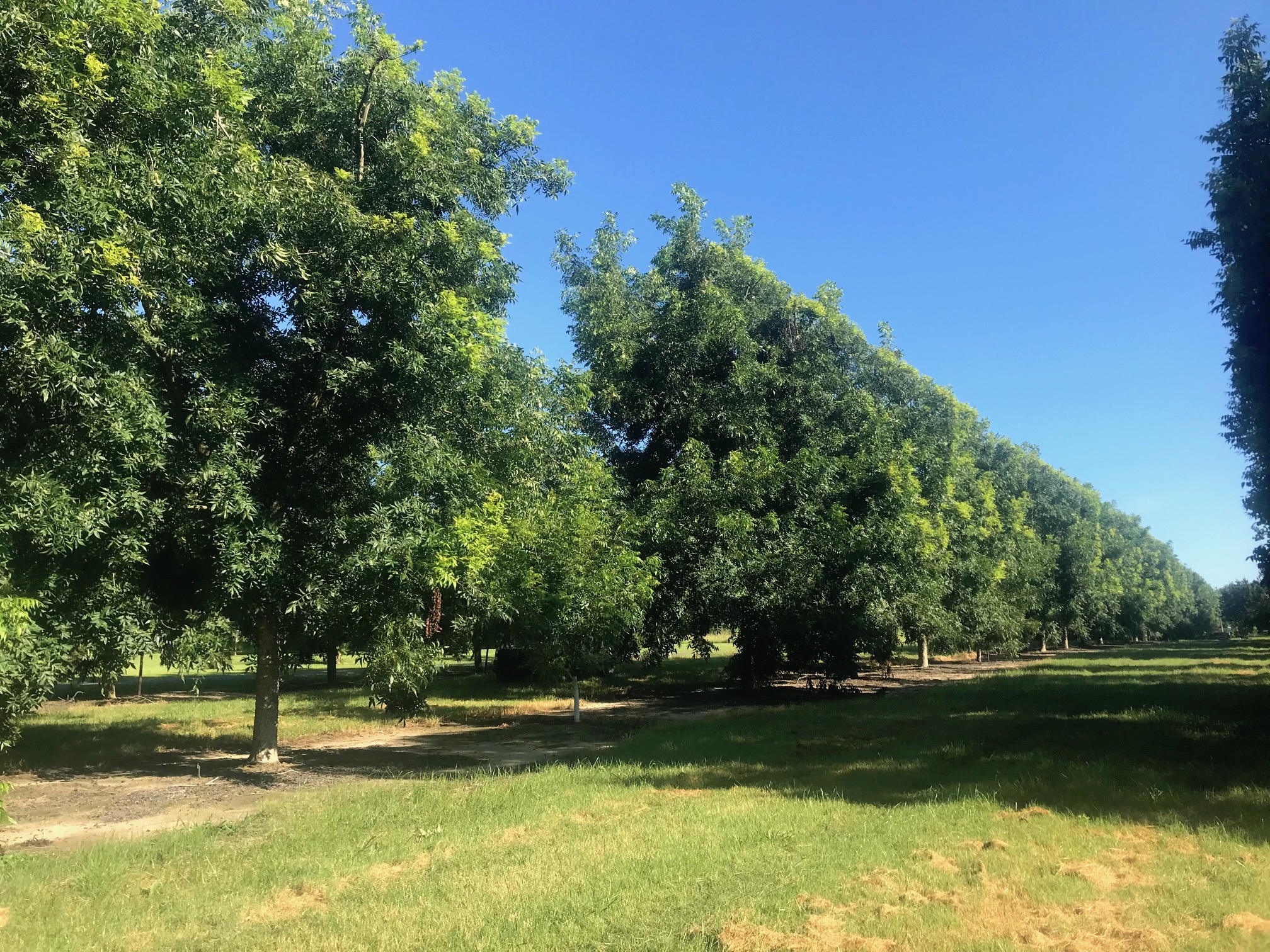Summer Tasks to Consider in the Pecan Orchard

Light green regrowth on pecan trees in late July 2020, following hedge-pruning in June 2020. (Photo by Lenny Wells)
The first point of significance in the current stage of the pecan crop is that June marks the beginning of nut sizing, in which the nuts begin to grow rapidly about halfway into the month. Over the next 10 weeks or so, the nuts will reach their full size. They are particularly vulnerable to pecan scab as they grow, making it critical to protect the nuts early in the sizing period. The earlier scab jumps out and begins development, the harder it is to stop and the more potential there is for disease loss.
If you spray today, you may do a good job of covering the exposed surface of the nut. But four to five days from now, as the nut sizes more, there will be a lot of new tissue that was not yet present five days ago and, therefore, will be unprotected. If it has been relatively dry during that period, you are ok. If it rains three times in those five days, you need to consider tightening your spray schedule up to at least 10 days on a susceptible cultivar.
Dr. Tim Brenneman’s past research has shown that certain fungicides work best on pecan nut scab and others work best on pecan leaf scab. The difference is not really in leaf scab versus nut scab. The same fungal pathogen causes disease on both tissues. Nor is the difference specifically in the chemicals themselves. The primary difference is found in the interaction between the disease, the fungicide, and the tissue surface it is growing on. Some fungicides, generally those with some level of “systemic” activity like the phosphites and group 3 + group 11 fungicides are the best materials out there for leaf scab. Other fungicides work on leaf scab as well, but either that is not their strong suit or it is not the best use of the material. Similarly, phosphite and the group 3 + group 11 materials work on nut scab, but either it is not the best use of these materials or other fungicides have performed better in Dr. Brenneman’s trials.
Elast and Tin both work better on nut scab than on leaf scab. These are pure protectant materials and, in combination, are one of the best options to spray during the nut sizing period. The Elast/Tin combo should be rotated with Miravis Top (Group 7 + Group 3), one of the best nut scab materials currently available, or perhaps under really heavy disease pressure, Miravis Prime (Group 7 + Group 12). For maximum protection from nut scab going forward, rotating Elast/Tin with Miravis Top or Prime should be considered.
Nut sizing also marks a significant increase in water demand by the tree. Water is the primary factor involved in maximizing nut size. Pecan trees have required very little water to this point in the season, but as the nuts begin to size, that demand increases with the energy required to fuel this process. Yet, in humid southeastern regions of the United States, rainfall helps and we only need to run irrigation at 36% of full capacity in June and 45% in July. This amount is sufficient to size the nuts properly. If you overwater during this period, it can become difficult to fill the nuts if the trees have a heavy crop load and we experience a dry August and September.
Nut drop is also noticeable during June. The second pecan nut drop, occurring in June, is the most commonly recognized drop. The June drop is brought on primarily by a lack of egg fertilization. Certain varieties, such as ‘Desirable,’ may drop 40 to 60% of the fruit on the tree. Therefore, you can’t reliably estimate what sort of crop potential ‘Desirable’ has until July in most cases. For such varieties, the drop is at least partially controlled by the trees and cannot be completely prevented, so don’t get too carried away worrying about June drop. It happens. Every year.
You should consider a shuckworm application in June, particularly if you have early maturing cultivars like ‘Pawnee.’ Later cultivars can likely wait until July for treatment. An insecticide that targets caterpillars would be the best choice of material and we have several of those available. Spraying a broad-spectrum material like a pyrethroid at this point would flare aphids and mites and lead to battles with those pests the rest of the season. First generation shuckworm damage is identifiable by the noticeable white residue on fallen nuts. Later generations will tunnel inside the shucks damaging the vascular connections which feed the nut. This can lead to a failure of the nuts to open (sticktights) that may not be noticeable until harvest, so it is important to be proactive against hickory shuckworm. They also overwinter in phylloxera galls; if you have noticeable phylloxera damage on your foliage or stems/nuts, be sure to include a shuckworm spray.
If you’ve had a stand of clover in your orchard, it saved you some early mowings. But the clover should have seeded out already or will be done soon, given our early spring. This means if you haven’t mowed the orchard yet, you can go ahead and do so once the clover seed has dried down and matured. This action will distribute the clover for re-seeding as you mow. Given the input costs for growing pecans and last year’s low market prices, you may want to consider spreading out the time between your orchard mowings. No one pays you for how the orchard looks, and mowing only once per month or even skipping a month won’t hurt anything as long as you begin mowing in late August/early September in time for the material to decay some prior to harvest.
We had a serious freeze event throughout the southeastern pecan belt back around Christmas of last year. It occurred late enough that trees should have been dormant and should not suffer any serious problems as a result. However, I do have concerns about young (1 to 3 years) trees that were fertilized after July of last year. Hopefully, we won’t have any problem, but if we do, it likely began to rear its head as temperatures warmed. Usually in June we start hitting temperatures in the upper 90s to 100s Fahrenheit and a tree with a freeze-damaged vascular system may have been able to support itself to this point, but we often see them crash once hot temperatures arrive.
There’s a lot going on in the orchard right now, and I know I’ve only scratched the surface. Hopefully, this sheds some light on a few important tasks to consider as we move into summer.

